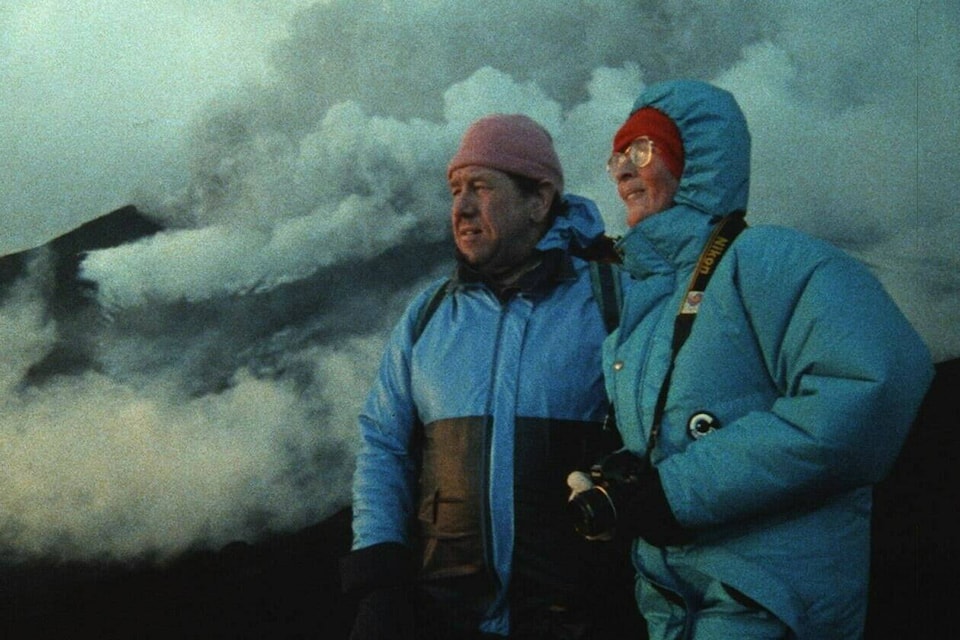The Oscar-nominated documentary “Fire of Love” begins with archival footage of two tiny figures venturing across a frozen tundra towards an active volcano.
Surrounded by mounds of icy slush, French volcanologists Maurice and Katia Krafft trudge ever closer to the rocky lip where at first no plumes of lava can be seen, but as they approach, steaming geysers come into view.
It’s one of several scenes in the Canada-U.S. co-production that depict the couple’s obsessive drive to discover the secrets of volcanoes, a shared passion nearly as fiery as their love story.
U.S.-Canadian producer Shane Boris says he and his collaborators were keen to explore the twin devotion the Kraffts had to their work, and to each other. The feature documentary is largely drawn from archival footage the Kraffts collected over a 25-year span.
“The first moment you see that footage, you’re completely mesmerized and awestruck by the enormity and brilliance,” Boris says of selections of archival footage.
“Once you also learn that there’s a love story in there too — there’s this real quest for being in touch with the elemental forces of the planet — that’s what touched me so deeply about their story.”
Boris says he has a penchant for films that “push the boundaries of conventional forms in order to tell timeless stories.”
“Fire of Love” is a nature documentary largely driven by visuals and the narration of actress and filmmaker Miranda July.
The film is competing at the Academy Awards on Sunday in the best documentary category. It’s up against U.S. opioid saga “All the Beauty and the Bloodshed,” Delhi-set bird conservation tale “All That Breathes,” Ukraine-set orphanage portrait “A House Made of Splinters” and the U.S. film “Navalny,” an investigation into the poisoning of Russian opposition leader Alexei Navalny.
Streaming now on Disney Plus, “Fire of Love” is also slated to be adapted into a narrative feature in a deal with Searchlight Pictures, with both Boris and the documentary’s director Sara Dosa attached as producers.
Boris and his Canadian collaborators, who include Montreal-based co-producer Ina Fichman and editor Jocelyne Chaput,say they acquired roughly 200 hours of the footage shot by the couple.
The Kraffts were famous across France in the ’70s and ’80s for gathering volcanic samples and getting dangerously close to active volcanoes to understand their mysteries.
They died during one of these expeditions June 3, 1991, when Japan’s Mount Unzen volcano erupted disastrously, killing 43 people including the Kraffts.
Chaput says the couple rarely appeared on camera because they dedicated their work to educating others on the wonders and dangers of volcanoes. Therefore, finding footage of the married couple together was a bit like looking for a needle in a haystack.
Chaput, Dosa and another editor sifted through hundreds of hours of geological footage, books, radio programs and interviews to portray the couple’s bond.
The film includes images of Katia and Maurice straddling the edge of craters, taking part in radio interviews, and making television appearances in France.
Chaput says the love story was influenced by a quote found in one of Maurice Krafft’s books: “Katia and volcanoes, it’s a love story.”
“In the editing room, striking that balance between allowing yourself to be engrossed by the world of volcanology, without losing the emotional thread of Katia and Maurice’s trajectory and love, was key,” she says.
“In the editing room, there was some experimentation — trial and error.”
“Fire of Love” explores themes of fear and life through two scientists who made it their life mission to get close to the lethality and burning forces of creation that they’ve acknowledged volcanoes to be.
“Some scientists believe that you have to be detached from the data which you study in order to see it as objectively as possible, but Maurice and Katia felt that they had to be close and intimate in some ways, like in love with what they were studying,” adds Boris.
“That was present in our approach to their material and in our approach to the film. I think we went much more for the intimate than for the detached, objective look.”
Boris, who also worked on “Navalny,” which was directed by Toronto’s Daniel Roher,says that a large percentage of the planet’s surface is actually solidified lava from a volcanic eruption. He sees a profound message in that about life.
“One of the things we learned about volcanoes was that when one thing is destroyed, another thing is created, that’s how volcanoes operate,” says Boris.
“When Katya and Maurice died unfortunately in the volcano, they became one with them, where new stories and myths were able to be told as a result of the story of their lives.”
Fichman says Fire of Love” was one of the most rewarding projects in her 30-year career.
“Every film you produce is a really unique experience and I have to say that this has been an extraordinary one for me on many levels,” says Fichman, whose credits include2017’s Emmy nominated “The Oslo Diaries” and 2018’s “Laila at the Bridge.”
“Not just for the Oscar nomination, but for this team and the collaboration with these very talented individuals.”
The Oscars air Sunday, March 12 at 8 p.m. ET/ 5 p.m. PT on CTV, CTV.ca and the CTV app.
—Noel Ransome, The Canadian Press



